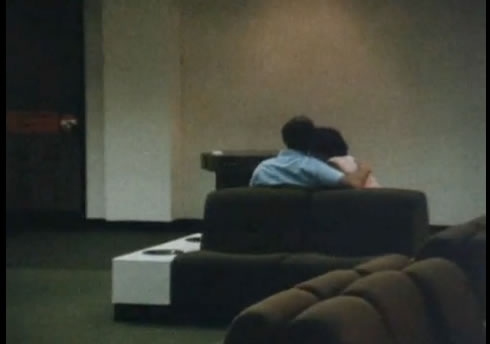
This still frame from TVNZ documentary 'Erebus disaster investigation' shows a couple waiting for passengers at Auckland Airport on the evening of the Erebus disaster.
Overdue
Air New Zealand's Antarctic Flight TE901 was scheduled to arrive in Christchurch at 7.05 p.m. (NZDT*). Around 50 passengers and the flight and cabin crew were expected to disembark. Friends and family of the disembarking passengers were waiting, along with a new crew scheduled to take the aircraft on to Auckland.
Those arriving to meet passengers were initially told that it was not unusual for the flight to run a little late as the pilots might have spent a little extra time sightseeing. But as the hours went on it became clear to all that something was wrong. Friends and family were closeted in a VIP lounge and provided with refreshments by Air New Zealand staff. They were eventually joined by members of the Salvation Army to comfort them.
By this time news that there was something wrong with the flight had been relayed to the Rescue Co-ordination Centre’s headquarters in Auckland and Police national headquarters in Wellington. Auckland Special Operations were given responsibility for confirming the passenger list, notifying next of kin that the flight was overdue, and obtaining various details from them. They passed details of overseas passengers to Interpol’s Wellington office – which in turn contacted their international counterparts to ask that they notify next of kin.
They also liaised with Oceanic Control, which was coordinating the New Zealand end of search and rescue operations. By 8 p.m. (NZDT) a RNZAF Orion had left from Whenuapai airbase, Auckland, to check the waters south of New Zealand. The Navy frigate Taranaki was also instructed to head to Dunedin to take on extra fuel and join the search.
It is unclear which media first broke the news, but some journalists were certainly aware something was wrong by around 7 p.m. (NZDT). Warren Head, a Christchurch Star journalist at the Air New Zealand-Shell Open Golf Championship, heard there was a problem just after 7. He rang his editor, Michael Forbes, and the paper’s Wellington correspondent, Ian Templeton, to advise them of the situation.
As Air New Zealand chief executive Morrie Davis packed for an immediate return to Auckland, a reporter got into his hotel room and asked him to comment on the overdue flight. He declined, but news of a problem with the flight was possibly announced in radio bulletins from this time onwards.
Other newspapers had certainly received news that the flight was overdue by approximately 8.20 p.m. (NZDT) and TVNZ interrupted its normal broadcasting with a special news bulletin on the flight just after 8.30. Newsreader Bill McCarthy stated that concerns were held for the flight, which had been out of touch for several hours, but noted that these were ‘unconfirmed reports’. Air New Zealand didn’t issue its first statement – confirming that the flight was overdue – until approximately 9 p.m. (NZDT). This was around the flight’s scheduled arrival time at Mangere airport, Auckland.
*On the day of the Erebus disaster there was a one-hour time difference between New Zealand and McMurdo Station. McMurdo Station was operating under New Zealand Standard Time (NZST) while New Zealand was operating under daylight saving or New Zealand Daylight Time (NZDT). Scott Base and McMurdo Station did not begin observing daylight saving until 1992/93.
Next page: Out of fuel

Community contributions